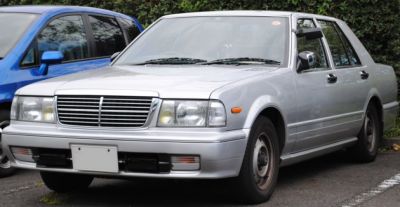 1983 Nissan Maxima I (G910) Dimensions, Size & Specs
1983 Nissan Maxima I (G910) Dimensions, Size & SpecsMeasurements of the 1983 Nissan Maxima I, engineered for optimal performance and comfort
| Dimensions | |
|---|---|
| Length: | 4670 mm183.9 in15.3 ft |
| Width: | 1645 mm64.8 in5.4 ft |
| Height: | 1395 mm54.9 in4.6 ft |
| Weight Specifications | |
| Curb Weight: | 1243-1350 kg2740-2976 lbs |
| Tire Specifications | |
| Rims Sizes: | 14-inch rims:
|
| Tire Size: |
|
The Nissan Maxima I (G910), produced between 1983 and 1984, represents the first generation of the Maxima line, classified as a mid-sized sedan. This generation offered a contemporary design for its era, combining practicality with a touch of sportiness. Measuring 4670 mm (183.9 inches) in length, 1645 mm (64.8 inches) in width, and standing 1395 mm (54.9 inches) tall, the Maxima I was designed to comfortably accommodate passengers while maintaining manageable external dimensions for urban and suburban driving.
With a curb weight ranging between 1243 kg to 1350 kg (2740 to 2976 pounds), the vehicle balanced a sturdy build with efficiency expected from cars in the early '80s mid-size sedan segment. It rolled on relatively modest 14-inch wheels fitted with 185/70 R14 tires, mounted on 5.5J x 14 rims, underscoring the focus on a smooth ride quality and stability.
The Nissan Maxima I entered the automotive market as a practical yet reliable option for families and professionals seeking a blend of comfort, size, and performance. Its size, notably longer and wider than many compact sedans of the time, positioned it well among competitors in terms of passenger space and trunk capacity. Despite its vintage, the Maxima I established a foundation upon which future generations would build more advanced technology, enhanced performance, and increased interior space.
In summary, the 1983-1984 Nissan Maxima I (G910) stands as a snapshot of 1980s Japanese engineering focused on producing a sedan with balanced external dimensions that catered to everyday use, emphasizing driver comfort and usability with a functional and straightforward design.
Discover the standout features that make the 1983 Nissan Maxima I a leader in its class
Have a question? Please check our knowledgebase first.
The Nissan Maxima I (G910), produced between 1983 and 1984, measures 4670 millimeters (183.9 inches) in length, 1645 millimeters (64.8 inches) in width, and 1395 millimeters (54.9 inches) in height. These dimensions make it a midsize sedan by the standards of the early 1980s, providing a good balance of interior space and urban maneuverability. The overall length and width contribute to comfortable seating for passengers, while the relatively low height enhances the car's aerodynamic profile and sporty stance.
The curb weight of the Nissan Maxima I (G910) ranges from 1243 kg to 1350 kg (approximately 2740 to 2976 lbs). This weight range reflects variations between trim levels and optional equipment. The moderate weight contributes to a balanced driving experience, offering stability and manageable handling characteristics. The weight-to-power ratio ensures that the car performs adequately for its class, providing decent acceleration and responsiveness typical for sedans of that era, without being overly heavy or underpowered.
Yes, the Nissan Maxima I (G910) fits comfortably inside a standard residential garage. With a length of 4670 mm (183.9 inches) and a width of 1645 mm (64.8 inches), it is well within the average garage dimensions, which typically range around 6000 mm (236 inches) long and 3000 mm (118 inches) wide. The car's height of 1395 mm (54.9 inches) also poses no issue for vertical clearance. Therefore, owners can securely park the Maxima in most homes with standard garages without any spatial concerns.
The Nissan Maxima I (G910) launched in 1983 essentially marked the introduction of the Maxima name in the North American market, succeeding the earlier Nissan Bluebird models which shared some design principles. Compared to the Bluebird predecessors, the Maxima I was longer and wider, with a length of 4670 mm (183.9 inches) and width of 1645 mm (64.8 inches), which gave it a more upscale and roomy feel. This represented a shift towards a larger, more comfortable sedan, aligning the Maxima with midsize to near-large sedans in the marketplace. The dimensions enhanced passenger comfort and cargo space, setting a new standard for Nissan in this segment.
When compared to contemporary midsize sedans from the early 1980s, such as the Toyota Camry or Honda Accord of that period, the Nissan Maxima I (G910) was similarly sized but leaned slightly towards the larger side in terms of length and width. With a length of 4670 mm (183.9 inches) and width of 1645 mm (64.8 inches), it offered more interior space without becoming unwieldy in urban environments. The height of 1395 mm (54.9 inches) contributed to a sportier, lower profile than some competitors, making it attractive to buyers looking for a mix of comfort and style.
The Nissan Maxima I (G910) came equipped with 14-inch wheels with dimensions of 5.5J x 14, paired with tires sized at 185/70 R14. These specifications ensured a balanced ride quality, combining a relatively narrow tire width with sidewall height sufficient to absorb road irregularities effectively. The setup contributed to a comfortable ride and responsive handling, consistent with the sedan’s intended use as a comfortable daily driver. The 14-inch rims were a standard size at the time, helping keep replacement tire costs reasonable while maintaining sufficient grip and stability.
Despite a relatively modest height of 1395 mm (54.9 inches), the Nissan Maxima I (G910) optimized its interior space efficiently thanks to its 4670 mm (183.9 inches) length and 1645 mm (64.8 inches) width. Passengers could enjoy a spacious cabin, especially in the front and rear seat areas, with upright seating positions typical of early 1980s sedans. The car’s architecture balanced sufficient headroom and legroom for average-sized adults, making it practical for small families or commuting professionals, with enough trunk capacity to handle daily cargo.
The Nissan Maxima I measures 1645 mm (64.8 inches) in width, which for its era was reasonably narrow by today’s standards. This width made it easier to navigate and park in tight urban settings where space was limited, such as city streets and smaller parking garages. While still wide enough to provide comfortable seating for passengers inside, the relatively narrow body avoided the bulkiness that many larger sedans exhibit, facilitating easier lane changes, parking maneuvers, and overall drivability in crowded areas.
The Nissan Maxima I (G910) came with a focus on reliability and balanced performance, typical of early 1980s Japanese sedans. Equipped with a smooth inline-6 engine, it provided sufficient power for daily commuting and highway driving, emphasizing fuel efficiency and longevity. While exact engine displacements and power outputs varied slightly by market, the Maxima was generally seen as a well-rounded car offering responsive acceleration and comfortable cruising speed. This made it competitive with other midsize sedans of the time and attractive for buyers seeking value and performance combined.
The Nissan Maxima I (G910) was succeeded by the Maxima II (A31) which debuted in 1987. Compared to the G910, the A31 generation featured a slightly larger and more aerodynamic design. The successor grew in overall length, width, and height, emphasizing more interior space and improved ride comfort. Design language also evolved to a sleeker, more modern look with smoother body lines and updated styling cues. The wheelbase lengthened, enhancing rear passenger legroom. This evolution reflected Nissan’s strategy to position the Maxima as a more premium and comfortable sedan compared to the slightly more utilitarian first generation.
Discover similar sized cars.

| Production: | 1988-1993 |
|---|---|
| Model Year: | 1987 |
| Length: | 4690 mm184.6 in |
| Width: | 1695 mm66.7 in |
| Height: | 1427 mm56.2 in |

| Production: | 1991-2014 |
|---|---|
| Model Year: | 1991 |
| Length: | 4690 mm184.6 in |
| Width: | 1695 mm66.7 in |
| Height: | 1425-1445 mm56.1-56.9 in |

| Production: | 1997-1999 |
|---|---|
| Model Year: | 1997 |
| Length: | 4695 mm184.8 in |
| Width: | 1695 mm66.7 in |
| Height: | 1460 mm57.5 in |

| Production: | 2002-2007 |
|---|---|
| Model Year: | 2003 |
| Length: | 4686 mm184.5 in |
| Width: | 1707 mm67.2 in |
| Height: | 1458 mm57.4 in |
